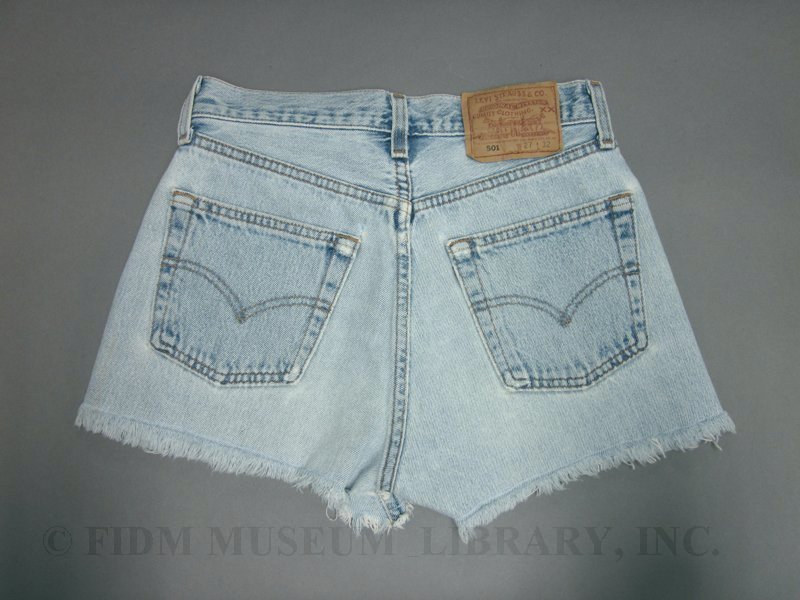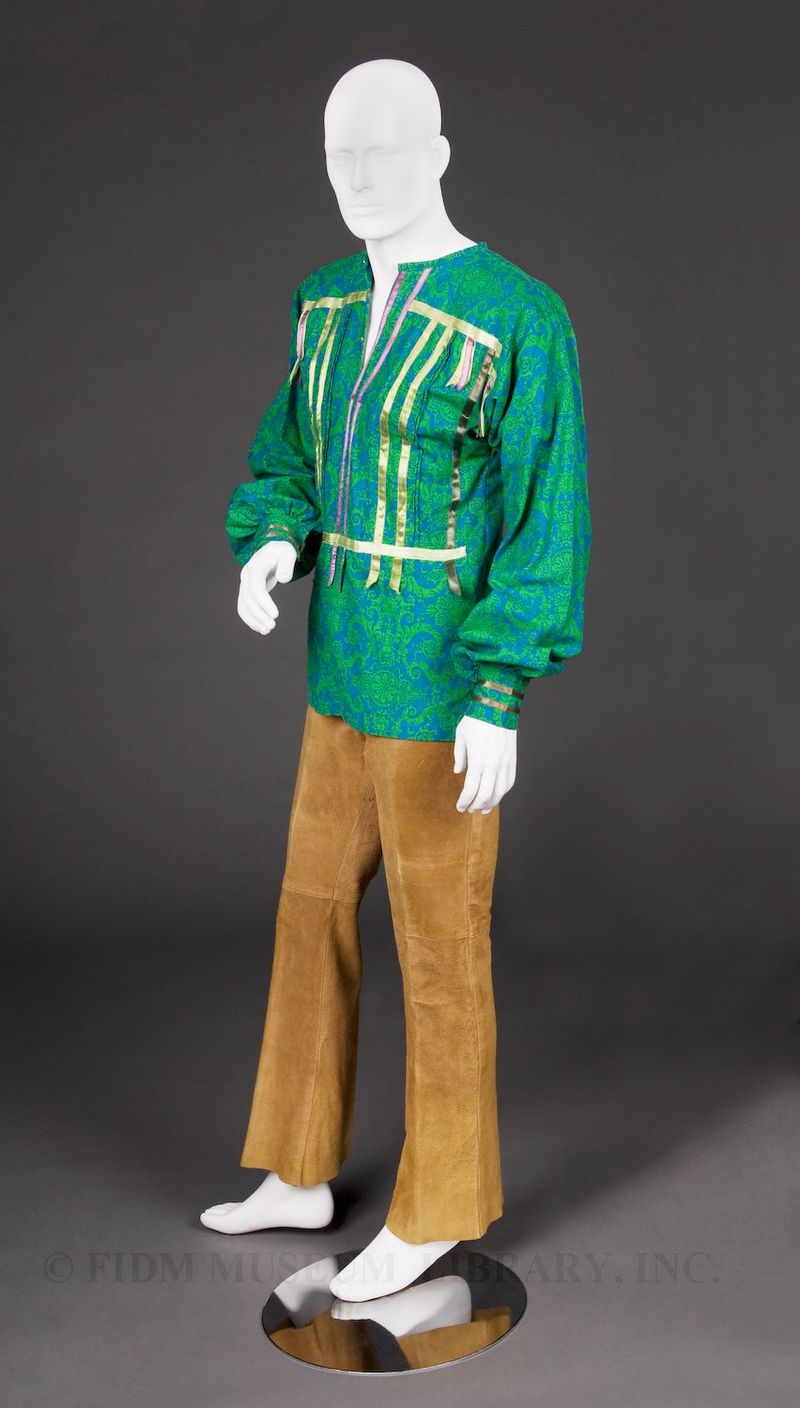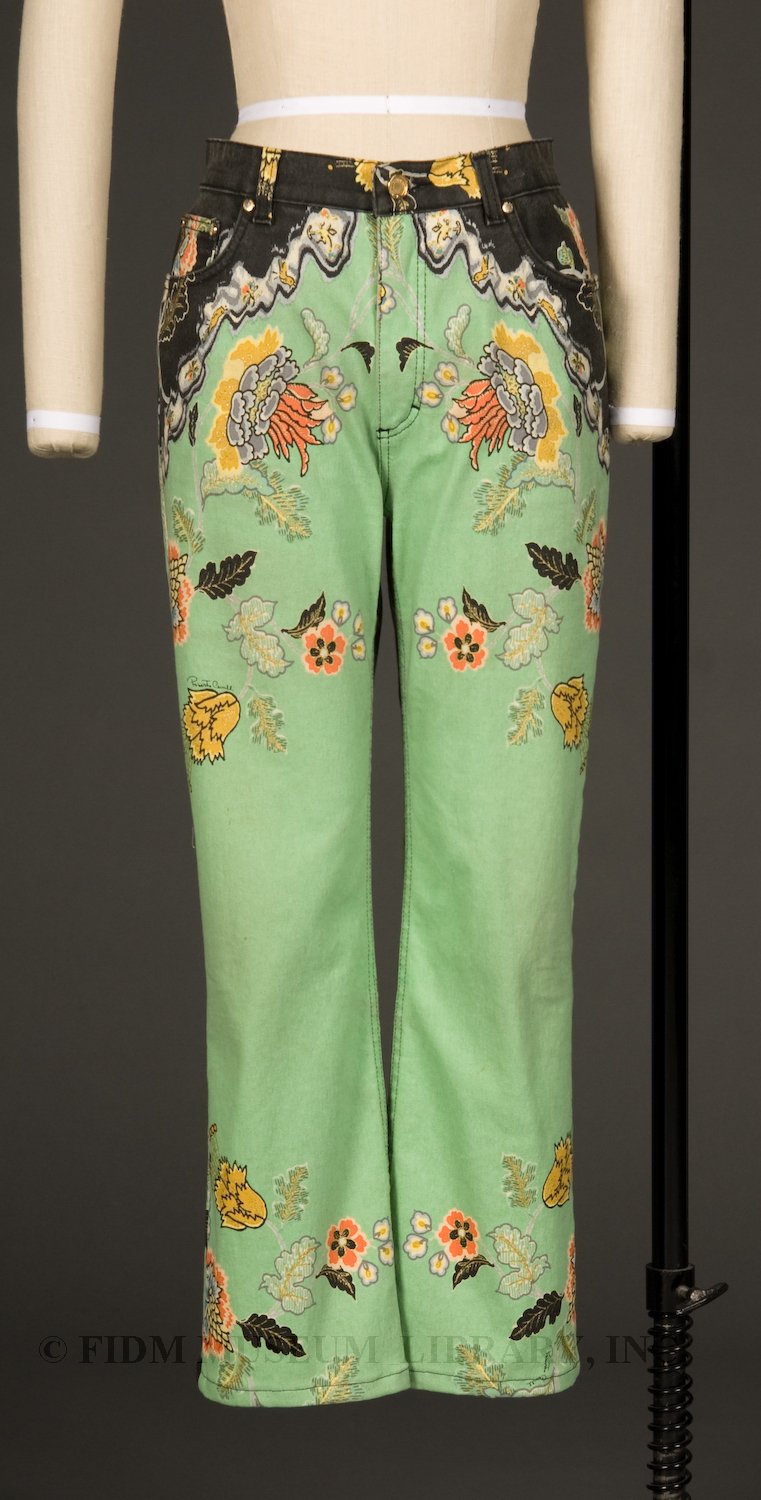Blue jeans, almost universally shortened to jeans, are the archetypal garment of the twentieth century. The name itself comes from a textile used to make workwear trousers worn by sailors in sixteenth century Genoa, Italy. An inexpensive and sturdy blend of cotton, wool and linen, it was called Génes after the French name for Genoa. Génes was anglicized to jean when the textile was imported to England, where it was widely used and manufactured. Jean evolved and by the eighteenth century was made entirely of cotton and used primarily for workwear. Pants made from jean fabric were commonly referred to as "jean pants," the origin of the contemporary name.
Somewhat confusingly, today's jeans are actually made from denim, a sturdy cotton twill weave textile. More durable than jean fabric, denim might be an anglicized name for a French textile called serge de nîmes. It has also been suggested that a canny eighteenth century British manufacturer applied a French-sounding name to his indigo dyed cotton textile, hoping to improve its prestige.
Denim and the particular style of pants called jeans, relatively slim, ankle-length trousers worn for work or casual dress, converged in the early 1870s. A Nevada tailor named Jacob Davis designed and made a pair of work pants with riveted pockets. The pants, made from blue denim or cotton duck, sold readily. Davis realized that it would be necessary to protect his riveted pockets with a patent, but couldn't afford the $68 application fee. Davis wrote to Levi Strauss, his San Francisco based textile supplier, with a suggestion that Strauss back the patent. Working together, the two businessman applied for a patent for denim "waist trousers" with riveted pockets. The patent was awarded in 1873, and Levi Strauss & Co. began manufacturing the new product. Davis, the actual inventor of waist trousers, oversaw the Levi Strauss & Co. manufacturing facility.
 Cut-off jean shorts
Cut-off jean shorts
Levi-Strauss & Co.
1975-1995
Gift of Dorothy Washington Sorensen
2010.1110.390
Though Levi Strauss & Co. was the first company to manufacturer this practical new pant, manufacturers large and small quickly followed suit. Other waist trousers appeared on the market even before the 1873 patent expired. All versions followed the model established by Davis and produced by Strauss & Co.: trousers made from durable denim with riveted pockets. If you placed a pair of nineteenth century waist trousers side-by-side with a pair of contemporary jeans, they would be remarkably similar. Details like waist-height and shape of the legs have changed over the years, but the basics of the garment remain the same. The pair of cut-off Levi shorts pictured above were probably shortened by the wearer, either for fashion or because the legs were worn out. This alteration highlights the late-twentieth century interest in showcasing the body and the easy adaptability of jeans.
 2010.1110.390 The Levi Strauss & Co. label used today, picturing two horses, is almost identical to the first label used by the company in 1873. The decorative stitched design on the back pockets, called an Arcuate, is also a long-stranding visual trademark of the brand.
2010.1110.390 The Levi Strauss & Co. label used today, picturing two horses, is almost identical to the first label used by the company in 1873. The decorative stitched design on the back pockets, called an Arcuate, is also a long-stranding visual trademark of the brand.
Designed as workwear, jeans were quickly popular with miners, farmers, loggers and cowboys. By 1900, a variety of regional manufacturers were creating workwear for local populations, including Carhartt (1884, Detroit) and OshKosh B'Gosh (1895, Wisconsin). The companies that would become iconic brands Lee (1911, Kansas) and Wrangler (1904, North Carolina) soon followed.
Via the popularity of Western-themed films, jeans entered the American imagination. John Wayne donned well-worn Levi's 501 jeans for his role in the 1939 film Stagecoach. Wayne reportedly "seasoned" his denim clothing by letting it soak in saltwater for several days. Other celebrities, including Tom Mix, Bing Crosby and Carole Lombard, wore jeans during public appearances and photographs. This glamorized portrayal of a previously humble garment broaden its appeal and cemented an association between jeans and leisure, rather than jeans and labor. Young people were the first to adopt this new style, as documented by a 1937 article in LIfe, which notes the popularity of jeans among Vassar undergraduates. According to the article, the style was introduced by students in an "Experimental Theatre" class.
During the 1940s, jeans were worn by war workers at home and by American serviceman abroad. In the post-war years, jeans became associated with rebellion and social disengagement. Worn onscreen and off by cinematic bad boys Marlon Brando and James Dean, jeans were appealingly dangerous. Worn by icon Marilyn Monroe, they gained a measure of sex appeal. Teenagers adopted the style in droves, and jeans were sometimes banned in American high-schools during the 1950s.
In the 1960s, jeans became widespread. For members of the hippie generation, wearing jeans was both a political and social statement, a way to reject the drab clothing and values of "straight"culture. New styles of jeans proliferated, including bell-bottoms of decorated or plain denim. The spread of jeans around the world was aided by the first generation of Peace Corps volunteers, who were issued blue jeans before departing the United States in 1961. This pair of late 1960s suede Levi's, are simply a slight variation on the classic denim jeans. You can read more about this pair of Levi's and the accompanying shirt in this post.
 Smock-style shirt and suede Levi's
Smock-style shirt and suede Levi's
Both c. 1967
Gift of Jay Hampel
Shirt 2007.801.5
Levi's 2007.801.4
By the 1970s and '80s, the phenomenon of designer denim indicated how far jeans had come from their humble origins as workwear. Designers like Gloria Vanderbilt and Calvin Klein produced the first wave of designer jeans, eventually leading to the proliferation of high-priced designer jeans available today. This pair of colorful Roberto Cavalli stretch jeans demonstrates just how far the "waist trouser" has evolved. Jeans are dressed-up or dressed-down and worn in nearly every situation. No longer associated with workwear or teenage rebellion, jeans are considered a wardrobe basic.
I'd bet that nearly everyone reading this post has at least one pair of jeans in their wardrobe, if not multiple pairs. If you're the rare person who doesn't own or wear jeans, drop us a line in the comments. It would be fascinating to hear how you've managed to resist this ubiquitous garment.
 Jeans printed in chinoiserie motifs
Jeans printed in chinoiserie motifs
Roberto Cavalli
1997-99
Museum Purchase
2005.5.159


I had my first Levi Outfit as Muse at a Rodeo Event at the University of the Philippines